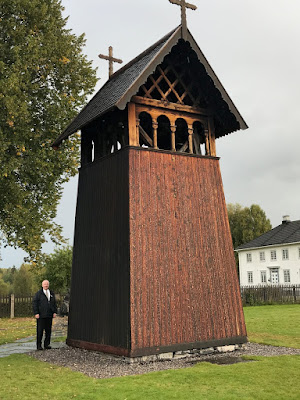Heddal Stav Kirke & Bygdetun

 |
| Traveling to Heddal |
 |
| Heddal Stav Kirke [wooden church with embedded posts] . There are about 23 of these still in Norway. They are fascinating to visit |
There is a legend telling about the erection of the church and how it was built in three days.
Five farmers (Raud Rygi, Stebbe Straand, Kjeik Sem, Grut Grene and Vrang Stivi) from Heddal had made plans for a church, and they decided to have it built. This is how it happened:
One day, Raud Rygi (one of the five men) met a stranger who was willing to build the church. However, the stranger, set three conditions for doing the job, one of which must be fulfilled before the church was finished:
Raud had three options: fetch the sun and the moon from the sky, forfeit his life-blood, or guess the name of the stranger. Raud thought the last would not prove too difficult, so he agreed to the terms
But time began to run out. All of the building materials had arrived during the first night, and remarkably, the spire was built during the second. It became clear to Raud that the church would be finished on the third day.
Down at heart and fearing for his life, Raud took a walk around in the fields trying to figure out what the stranger's name could be. Still wandering about he had unconsciously arrived at Svintruberget (a rocky hill southeast of the church site) when he suddenly heard a strange but most beautiful and clearly audible female song:
- Hush-hush little Child,
- Tomorrow Finn will bring you the Moon and the Sky.
- He will bring you the Sun and a Christian Heart,
- so pretty Toys for my little Child to play a Part.
Or in Norwegian
- I morgen kommer Finn og bringer oss maanen
- der han kommer forgaar sol og kristenblod
- lokker barna til sang og spel
- men nå mine små, sov stille og vel
Now Raud knew what to do, as the stranger was a mountain troll. As expected, the stranger visited Raud the next day, to present the church. Together they walk over to the church, and Raud walks up to one of the pillars, hugs it as if to straighten it, and says, "Hey Finn, this pillar isn't straight!" Finn snaps back, “I could be even more bent!” and then hastily leaves the church. Raud had solved the riddle after all. The stranger's name was Finn and he lived in the Svintru Mountain. Finn, also known as Finn Fairhair or Finn Fagerlokk, a troll, could not ever after stand the sound of church bells, so he moved along with his family to Himing (Lifjell).
 |
| We arrived about 10 minutes before they closed so we were able to see the inside of the church also. |
 |
| Bell tower across the lane from the church |


 |
| Heddal Bygdetun - open air museum - Heddal Museum has various buildings representative of the history of local farming dating from the middle ages up until 1930's. |





The museum cabins were closed. They are only open from June - August each year. But here are a few pictures that will give you an idea of what they are like. They show the traditional budnad and rosemaling paintings that are typical in the Telemark region.





























Comments
Post a Comment